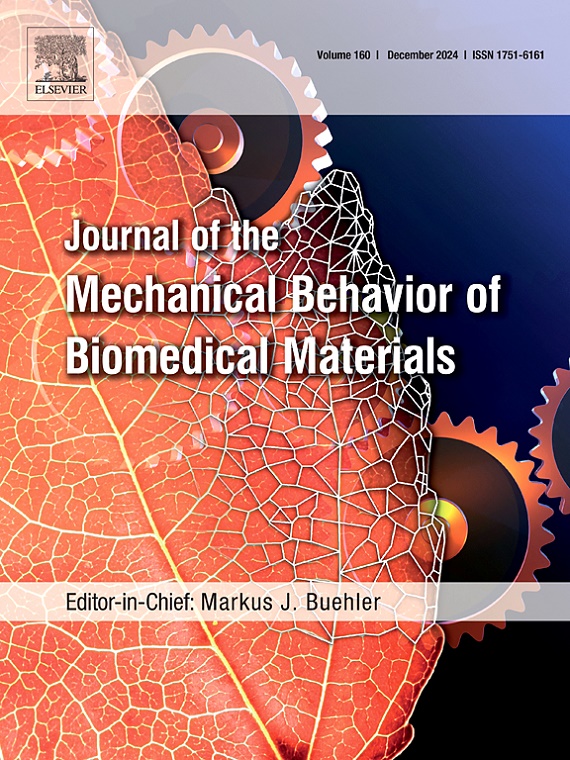Wear and friction resistance of UHMWPE with anisotropic microstructure shaped by mechanical compression
IF 3.3
2区 医学
Q2 ENGINEERING, BIOMEDICAL
Journal of the Mechanical Behavior of Biomedical Materials
Pub Date : 2025-03-14
DOI:10.1016/j.jmbbm.2025.106980
引用次数: 0
Abstract
This study investigates the tribological behavior of UHMWPE with an anisotropic microstructure induced by uniaxial compression. Reciprocating sliding tests were conducted under loads exceeding the material's elastic limit to reveal differences in friction and wear when sliding parallel (LD) and perpendicular (FD) to the compression axis. The experiments were conducted under a severe wear regime, exceeding the typical contact stresses in orthopedical prostheses. The results highlight the influence of mechanical deformation on wear resistance and friction, providing insights for optimizing UHMWPE performance in biomedical and industrial applications. The molecular structure of the original and compressed UHMWPE specimens was assessed using AFM images, and the microstructural phases were quantified through Raman spectroscopy. The originally directionless lamellar structure appeared aligned along the FD direction in the compressed specimen. Besides that, the amount of crystalline phase, near 50 % in the original specimen, increased to 57 % when the laser beam is polarized along the FD direction and decreased to 29 % polarized along LD direction in the deformed specimen, indicating permanent anisotropy in the polymeric material due to mechanical compression. The average amount of polymer's microstructural phases clearly changed after sliding process, quite considerably in the compressed specimens. Testing along FD path further increased the crystalline phase in this direction, from 57 % to 66 % after the test. In LD direction the same phase increased from 29 % to 76 % after the test, even reversing the microstructural anisotropy in this case. A larger volume of debris was produced in the plastically deformed polymer specimen in comparison to the original material, independently of the tested direction, and despite the increase in the crystalline phase in the deformed material. The pre-strained material demonstrated more susceptibility of to wear, with no correlation with the crystallinity extent of the material. In conclusion, the results contribute to a better understanding of material deformation mechanics, providing insights into optimizing wear resistance in high-stress environments.
机械压缩形成各向异性微观结构的超高分子量聚乙烯耐磨性
研究了具有各向异性微观结构的超高分子量聚乙烯在单轴压缩下的摩擦学行为。在超过材料弹性极限的载荷下进行往复滑动试验,以揭示与压缩轴平行(LD)和垂直(FD)滑动时的摩擦磨损差异。实验是在严重磨损状态下进行的,超过了骨科假体的典型接触应力。研究结果强调了机械变形对耐磨性和摩擦的影响,为优化超高分子量聚乙烯在生物医学和工业应用中的性能提供了见解。利用原子力显微镜(AFM)对原始样品和压缩样品的分子结构进行了表征,并通过拉曼光谱(Raman spectroscopy)对微观结构相进行了定量。压缩试样中原本无方向性的片层结构出现沿FD方向排列。此外,当激光束沿FD方向偏振光时,原始样品中晶体相的数量接近50%,而变形样品中晶体相的数量增加到57%,而沿LD方向偏振光则减少到29%,这表明由于机械压缩,聚合物材料具有永久的各向异性。压缩试样中聚合物微观结构相的平均数量在滑动过程中发生了明显的变化,且变化幅度较大。沿着FD路径测试进一步增加了该方向的晶相,测试后从57%增加到66%。在LD方向上,同一相从29%增加到76%,甚至逆转了微观结构的各向异性。与原始材料相比,在塑性变形的聚合物样品中产生了更大体积的碎片,与测试方向无关,尽管变形材料中的结晶相增加了。预应变材料表现出更大的磨损敏感性,与材料的结晶度无关。总之,研究结果有助于更好地理解材料变形力学,为优化高应力环境下的耐磨性提供见解。
本文章由计算机程序翻译,如有差异,请以英文原文为准。
求助全文
约1分钟内获得全文
求助全文
来源期刊

Journal of the Mechanical Behavior of Biomedical Materials
工程技术-材料科学:生物材料
CiteScore
7.20
自引率
7.70%
发文量
505
审稿时长
46 days
期刊介绍:
The Journal of the Mechanical Behavior of Biomedical Materials is concerned with the mechanical deformation, damage and failure under applied forces, of biological material (at the tissue, cellular and molecular levels) and of biomaterials, i.e. those materials which are designed to mimic or replace biological materials.
The primary focus of the journal is the synthesis of materials science, biology, and medical and dental science. Reports of fundamental scientific investigations are welcome, as are articles concerned with the practical application of materials in medical devices. Both experimental and theoretical work is of interest; theoretical papers will normally include comparison of predictions with experimental data, though we recognize that this may not always be appropriate. The journal also publishes technical notes concerned with emerging experimental or theoretical techniques, letters to the editor and, by invitation, review articles and papers describing existing techniques for the benefit of an interdisciplinary readership.
 求助内容:
求助内容: 应助结果提醒方式:
应助结果提醒方式:


